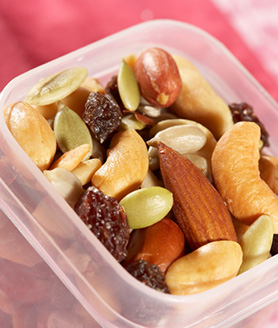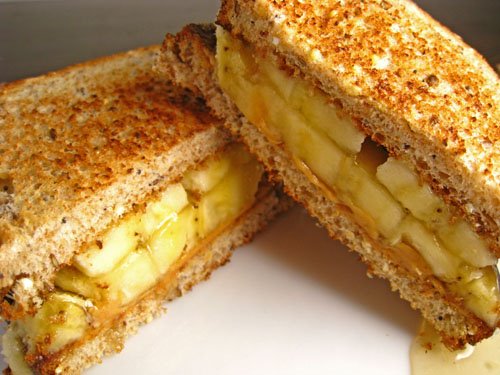What to Eat or Drink after a Golf Tournament
Sometimes golfers think that the rules of sports nutrition don’t apply to them or that they can tough out a tournament with minimal dietary preparation.
But the reality is just the opposite. Because golfers play multiple rounds during a day (and play multiple days back-to-back), it’s essentially impossible to perform well in every game if you aren’t taking in food and fuel. While this may seem like the time when your body is the least picky about food, performing at your peak requires a game day nutritional game plan.
Here are some tips and recommendations for snacks during tournament play:
1. Your tournament snacks should, ideally, be as food-like as possible.
On the spectrum of energy drinks, protein powders, gels, Shot Bloks, and protein bars to sandwiches, bananas, and nuts, try to have the majority of your fuel be real food. Real food means food that is minimally processed and doesn’t contain tons of added preservatives, sweeteners, chemicals, and additives.
Sports nutrition products are often a mishmash of weird ingredients. The ingredients for Shot Bloks, for example, are tapioca syrup, dried cane syrup, maltodextrin, pectin, citric acid, caffeine, electrolytes, and a handful of stabilizers and preservatives. These aren’t real foods — and while they might give you a burst of energy, their “nutrition” is unsustainable for a full day of any sport. Real foods, or foods that are made up mostly of real foods (like fruit, nut, and seed-based bars) provide calories, carbohydrates, protein, fats, and electrolytes, giving your body real energy to run hard.
If you’re concerned about electrolytes, or if you’re playing in hot and humid weather, I recommend electrolyte enhanced drink tablets like Nuun, which offer sodium, potassium, magnesium, and calcium but with no added sugars.
There is, however, a time and a place for sports drinks, gels, and Shot Bloks — and that’s for athletes who can’t handle much, or any, solid food during a tournament. See below…
2. Your tournament snacks should fuel you through eight or more hours of ultimate.
As I’ve mentioned before, playing golf all day burns a good amount of calories–and it’s important to fuel your body while (not just before and after) you’re playing. This starts with a healthy breakfast. After that, what, how much, and how often you eat depends on how well you can digest food and then exercise immediately after. These factors can vary quite a bit between golfers, so it’s important to figure out what works for you.
Practice is a perfect time to figure out the types and timing of snacks that will maximize your performance. In general, snacks should combine carbohydrates, protein, and fat–but the exact ratios will be different for everyone. There are a slew of studies that claim that one carb to protein to fat ratio—or fueling with fluids as opposed to solids–is better than another, but it’s important to remember that real life isn’t a clinical study. We’re not playing in a laboratory where all confounding variables are controlled; just because fifteen male endurance cyclists cycled faster and for longer when they sipped on a sports drink compared to when they ate a banana doesn’t mean that you will too.
3. Your tournament snacks should not hinder your ability to play, either by causing GI discomfort or by not providing enough energy.
The previous two points mean nothing if your snack leads to discomfort. If you’re the type of person who can’t handle a lot of solid food during tournaments, you may have to rely on the more processed foods that I mentioned above. Fast-burning or high glycemic index carbs (carbohydrates that are absorbed into your bloodstream at a faster rate; these include foods like white bread, pretzels and dried fruits) may also be a better choice than slow-burning or low glycemic index carbs (carbohydrates that are absorbed at a slower rate; these include many whole grains, beans, legumes, most fruits, and vegetables). Dried fruit and nuts are another healthy option because they’re energy dense but don’t take up a lot of room in your stomach.
Likewise, the previous two points also mean nothing if you’re not taking in enough fuel to play your best. Throughout the years, I’ve seen many golfers who don’t pack enough (or any) food, who barely eat any food at all, or who subsist solely off of highly processed foods like energy drinks, candy bars, and potato chips. Eating too few calories is a problem I see players make often, and I think it’s one big reason why many golfers crash at the end of the day. Even eating incredibly healthy, nutrient-dense foods that I would otherwise recommend as a heathy snack — raspberries and kale, for example — will not provide enough calories to fuel you through a tournament. Quantity and quality need to be taken into consideration: focus on getting enough calories from high quality foods, and aim to get carbohydrates, healthy fats, and protein in every snack to provide sustained energy.
Other Tips
Eat often
Many sports nutritionists say that once you’re thirsty, you’re becoming inadequately hydrated–and you’re already playing below your optimal level. Hunger is similar, but the effects are even more pronounced–once you’re hungry, your abilities are reduced significantly. Your decision-making may also take a hit; hunger strikes, and you’re no longer the best golfer you can be. For most people, I recommend eating small amounts of food often (every couple of holes, for example) as opposed to large amounts only a few times a day. This will provide your body with sustained energy, and your GI tract won’t be as stressed since you’re eating such small amounts of food.
Bring options
I could probably live off the food in my tournament bag for three days—not because I actually eat that much, but because I want options. I pack a number of different brands and flavors of bars (my favorite brands are KIND, Zing, and Rise), multiple Justin’s Nut Butter packets, nuts and seeds, apples, snap peas, and at least one Schlagwich [see below]. I don’t eat all of my food–or even come close to it–because the point is to have options when I come off the course. Sometimes I want a bite of a bar and sometimes I want a handful of snap peas. Packing options will allow you to eat the food that your body wants at that specific time, maximizing performance and minimizing GI discomfort.
Ideal Snacks
Banana and Justin’s Nut Butter: A banana contains easy-to-digest carbohydrates, while Justin’s Nut Butter squeeze packs provide more calorie-dense energy with protein and fats .These are perfect sideline snacks because both are portable; and the squeeze packs allow you to squeeze out as much or as little almond or peanut butter as you want.
Schlagwich: My teammates branded this sandwich “The Schlagwich” after I showed up to every practice and tournament with at least one, running off to the sideline every so often to grab a bite. It’s made with whole grain bread, almond butter, apple slices, and cinnamon. The fast-burning carbs in the apples provide immediate energy, while the slow-burning carbs in the whole grain bread, as well as the fat and protein in the almond butter, provide lasting and sustained energy.
Jerky and Fruit: Bite-sized pieces of low fiber fruits (watermelon, cantaloupe, grapes, mangos, and bananas) are high in carbohydrates, offer immediate energy, and are accessible between points. Jerky adds protein to help begin recovery (even if you’re not done playing) as well as the salt that many golfers crave throughout the day.



